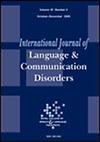Speech and language therapist-led clinics for low-risk suspected head and neck cancer referrals: A qualitative study of ear, nose and throat surgeons’ views
Abstract
Background
Over 200,000 patients are referred onto the suspected head and neck cancer (HNC) pathway annually in the UK, with around 3% receiving a cancer diagnosis. With new HNC advancements in identifying patients at low risk of a cancer diagnosis, one proposal is a speech and language therapy (SLT)-led first point of contact clinic for low-risk patients presenting with voice or swallowing symptoms.
Aims
To explore ear, nose and throat (ENT) surgeons’ views regarding this model.
Materials & Methods
The study used a qualitative study design using semi-structured interviews. Transcribed responses were analysed using thematic analysis.
Outcomes & Results
A total of 11 UK ENT surgeons participated. Themes included the positives and challenges of the proposed model; existing facilitators that increase the likelihood of success; and the requirements for successful implementation. Service variation impacted level of interest. Waiting times were problematic at some sites more than others; SLT workforce issues were of differing prevalence; SLT competence and interest differed; and support from organizational leaders varied. Participants’ personal views also varied, for example, acceptability of the model to patients, or what governance structure is required. There was no single SLT-led clinic model suitable for all centres; however, some general principles were identified to inform further evaluation and implementation of this model.
Conclusions & Implications
Principles included the deployment of SLTs experienced in laryngeal examination and flexible nasendoscopy; dedicated job plans and workforce; professional and regulatory body recognition and support; and clear training, supervision structure and job description for the role. Service outcomes, training protocol and competencies require robust evaluation.
WHAT THIS PAPER ADDS
What is already known on this subject
- During the SARS-CoV-2 pandemic, a risk calculator tool was developed to identify patients at highest risk of cancer who were referred to the 2-week-wait (2ww) ENT pathway. These patients require urgent face to face ENT assessment. Lower risk patients with voice and swallowing difficulties still require management of their symptoms and an SLT-led clinic model is one potential solution for this population. While SLTs’ views of this model have been explored with a UK-wide survey and focus groups, ENT surgeons’ perspectives are yet to be investigated.
What this study adds to the existing knowledge
- This study explores ENT surgeons’ views regarding SLT-led clinics for patients who are referred through the 2ww ENT pathway, stratified as being at low risk of cancer, and with voice and/or swallowing symptoms of likely benign aetiology. Participants shared many positive perceptions of the clinic along with factors that they felt would enhance its success (facilitators). Key requirements for the success of this clinic model were also highlighted, along with challenges that need to be addressed.
What are the practical and clinical implications of this work?
- The need for this clinic model varied by centre. However, general principles included the importance of a dedicated workforce with pre-existing relevant expertise; and a clear role profile, training process and competencies framework. Professional, statutory and regulatory bodies’ recognition of the role is required, and robust evaluation of the model is necessary.

 求助内容:
求助内容: 应助结果提醒方式:
应助结果提醒方式:


